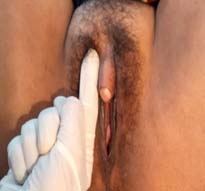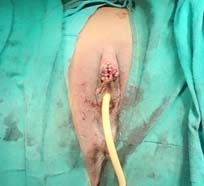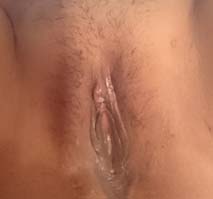Acquired Clitoromegaly: A Gynaecological Problem or an Obstetric Complication?
Mamta Gupta1, Vandana Saini2, Anju Poddar3, Supriya Kumari4, Ashesh Maitra5
1 Senior Specialist and HOD, Department of Obstetrics and Gynaecology, Hindu Rao Hospital & Associated NDMC Medical College, Delhi, India.
2 Senior Specialist, Department of Obstetrics and Gynaecology, Hindu Rao Hospital & Associated NDMC Medical College, Delhi, India.
3 Senior Specialist, Department of Obstetrics and Gynaecology, Hindu Rao Hospital & Associated NDMC Medical College, Delhi, India.
4 Postgraduate Student, Department of Obstetrics and Gynaecology, Hindu Rao Hospital & Associated NDMC Medical College, Delhi, India.
5 Postgraduate Student, Department of Obstetrics and Gynaecology, Hindu Rao Hospital & Associated NDMC Medical College, Delhi, India.
NAME, ADDRESS, E-MAIL ID OF THE CORRESPONDING AUTHOR: Dr. Mamta Gupta, A-18, Greenview Aptt. Sector 9, Rohini, Delhi-110085, India
E-mail: write2mamta55@gmail.com
Acquired non-hormonal clitoromegaly is a rare condition and is due to benign or malignant tumours and sometimes idiopathic. Few cases of clitoral abscesses have been reported after female circumcision. We hereby report a case of clitoral abscess causing acquired clitoromegaly following an obstetrical surgery.
Clitoral abscess, Obstetrical surgery
Case Report
A 24-year-old woman was referred from a secondary care hospital as a case of urethral stenosis. Her presenting complaints were pain in perineal region and pain during micturition since last 4 months. There was no history of fever, burning or frequency of passing urine There was no history of any discharge or bleeding per vaginum. She was gravida 1, para 1. Last child birth was 4 months back delivered by cesarean section. She was breast feeding her child and had lactational amenorrhoea. There was no history of any medical treatment received for her present complaints or any surgical intervention in the perineal region. Her antepartum and intrapartum periods were uneventful except in the immediate postpartum period when she had pain in perineal region which further aggravated during micturition.
On general examination she was an average built healthy looking female. There was no hirsutism, breasts were fully developed, milk secretion was present. Axillary and pubic hairs were normal. Systemic and per abdomen examination did not reveal any abnormality. There was no inguinal lymphadenopathy.
On local examination, clitoromegaly was seen, about 3.5 cm X 1cm (clitoral index =350 mm2), with normal overlying skin and phallus [Table/Fig-1] which was slightly tender. Per speculum and per vaginum examination did not show any abnormality. Urine routine examination was normal. Urine culture was sterile after 24 hours. Her total testosterone level was 24.67ng/dL, DHEA-S was 102.3 mcg/dL (reference range for females of 18-29 years : 44-332mcg/dL) [1].

USG abdomen was normal and no tumour was seen in adrenals. Uterus was normal size with normal bilateral adenexa. Transperineal ultrasound revealed an oblong, cystic lesion of size 3.3 cm X 1cm in clitoris with internal echoes suggestive of haematoma.
With provisional diagnosis of haematoma, she was put on analgesics and anti-inflammatory drugs along with a course of ciprofloxacin 500 mg BID with tinidazole 500 mg BID. She was reviewed after a week. The size of swelling remained same but her pain was relieved. It was cystic not attached to underlying tissues and nontender. She was reviewed again after 10 days expecting that the haematoma may have resolved. However, the swelling was found to be persistent hence, FNAC (Fine Needle Aspiration Cytology) was decided to rule out any malignancy.
During FNAC, to our surprise, about 5-6cc frank thick pus was obtained and the clitoromegaly immediately regressed. Pus was sent for culture and sensitivity which was reported as sterile. Incision and drainage was planned under anaesthesia after pre-anaesthesia investigations and check up. Under general anaesthesia, urethra was catheterized, incision and drainage of pus was done followed by marsupilization [Table/Fig-2]. Follow up on postoperative day 10 revealed that the entire swelling had disappeared with near normal anatomy of the clitoral region [Table/Fig-3].
Drainage of pus folllowed by marsupilisation.

On postoperative on day 10.

Discussion
Clitoromegaly is defined as a measure of the clitoral index (width × length in mm) more than 35mm2 [2]. It can be congenital or acquired. Congenital causes are-congenital adrenal hyperplasia due to enzyme deficiency, babies of mothers having ingestion of androgens or drugs having androgenic actions i.e. norethisterone/danazole etc. during pregnancy, luteomas, theca-lutein cysts, virilizing adrenal or ovarian tumour during pregnancy.
Acquired causes are PCOS, hyperthecosis ovarii, arrhenoblastoma, drugs induced and adrenal tumours. Various benign and malignant tumours of clitoris [Table/Fig-4] can also present as clitoromegaly [3-12]. Metastasis from distant organs can also cause clitoromegaly. Sometimes pseudoclitoromegaly can be found in girls as a result of masturbation. It can also be idiopathic.
Acquired clitoromegaly: Case reports [3-12].
| Author | Age years | Year | Diagnosis |
|---|
| Dhande A [3] | 7 | 2015 | Neurofibroma |
| Santosh Kumar [4] | 42 | 2014 | Leiomyoma |
| A Padmaja [5] | 17 | 2014 | Idiopathic isolated clitoromegaly |
| Azurah AG [6] | 6 | 2013 | Benign schwannoma |
| Adriano Luis Gomes [7](3 cases) | | 2013 | |
| 10 | | Lympho-angiofibroma |
| 2 | | Epidermoid cyst |
| 1 | | Fibroma |
| Singh A [8] | 18 | 2012 | Vascular hamartoma |
| Gazic B [9] | | 2011 | Pilomatrix carcinoma |
| Esther Maor Sagie [10] | 8 | 2010 | Pilonidal sinus |
| Mandal S [11] | 6 | 2009 | Intradermal nevus |
| Youssef Al Tonbary [12] | 3 | 2008 | Rhabdomyosarcoma |
We reviewed the literature for clitoral abscess as a cause of acquired clitoromegaly on pubmed and medline using keywords clitoral abscess but we could not find any such cause or case report of clitoral abscess related to obstetric event. However, few cases of periclitoral abscess [13-15] have been reported presenting as labial swelling and extending till clitoral region or swelling near the clitoral region.
AA Rouzi reported epidermal inclusion cysts to be a common complication, in countries where female circumcision (Female Genital Mutilation/FGM) is common [16]. Among the 32 cases of clitoral cysts, only 1 was infected and the clitoral abscess was drained.
In our case the clitoral abscess appeared to have formed in an infected haematoma. The diagnosis of urethral stenosis while being referred at tertiary care hospital, history of onset of pain in perineal region aggravated by micturition in the immediate postpartum period, suggests that there must have been some difficulty in insertion of urethral catheter and probably some injury might have happened in the clitoral region. This injury had led to the formation of a haematoma which later became infected to form an abscess causing clitoromegaly. However, an idiopathic cause of the clitoral abscess cannot be ruled out.
Conclusion
Symptoms of UTI following caesarean section may not be always due to urinary tract infection. A gynecological examination is necessary to rule out traumatic sequelae even if the delivery is by abdominal route. Clitoral swelling if detected in postpartum period can occur due to direct obstetric trauma including the simplest of surgical intervention like urethral catheterization as in this case.
[1]. Elhomsy G, Griffing GT, Dehydroepiandrostenedione (DHEA) sulphate. Chief editor Eric B StaresMedscape.com 2014 [Google Scholar]
[2]. Tagatz GE, Kopher RA, Nagel TC, Okagaki T, The clitoral index: a bioassay of androgenic stimulationObstet Gynecol 1979 54(5):562-64. [Google Scholar]
[3]. Dhande A, Chougle QA, Lal V, Gupta S, Dhande K, Neurofibroma presenting as clitoromegalyInt J Res Med Sci 2015 3(12):3887-88. [Google Scholar]
[4]. Kumar S, Agrawal S, Jayant K, Shankargowda SA, Large Clitoral Leiomyoma in a 42-Year-old Premenopausal WomanNephrourol Mon 2014 6(3):e17022Published online 2014 May 12 [Google Scholar]
[5]. Padmaja A, Chitranshi A, Idiopathic acquired clitoromegaly: A case reportRCOG World congress 2014 poster ID 1211 [Google Scholar]
[6]. Azurah AG, Grover S, Mcgregor D, Plexiform Schwannoma of the clitoris in a young girl: A case reportJ of reprod medicine 2013 58(7-8):365-68. [Google Scholar]
[7]. Gomes AL, Onofre LS, Leão JQ de Souza, Leão FG, Cruz TMA, Sircilli MHP, Clitoral anomalies not associated with disorders of sex developmentJournal of Pediatric Surgery Case Reports 2013 1(11):403-05. [Google Scholar]
[8]. Singh A, Chitragar SS, Dadhwal V, Jindal VL, Sharma AK, Suri V, Vascular hamartoma: an unusual cause of clitoromegaly in an 18-year-old patientLow Genit Tract Dis 2012 16(3):325-27. [Google Scholar]
[9]. Gazic B, Sramek-Zatler S, Repse-Fokter A, Pizem J, Pilomatrix carcinoma of the clitorisInt J Surg Pathol 2011 19(6):827-30. [Google Scholar]
[10]. Maor-Sagie E, Arbell D, Prus D, Israel E, Benshushan A, Pilonidal cyst involving the clitoris in an 8 year old girl – a case report and literature reviewJ Pediatr Surg 2010 45:e27-e29. [Google Scholar]
[11]. Mandal S, Dhingra K, Gupta P, Khurana N, Acquired (idiopathic) intradermal nevus with junctional activity presenting as clitoromegaly in a child: report of a caseEur J Pediatr 2009 168(11):1405-07. [Google Scholar]
[12]. Al-Tonbary Y, Zalata K, Sarhan M, El-Ashery R, Fouda A, Rhabdomyosarcoma of the clitorisHematol Oncol Stem Cel Ther 2008 1(2):133-35. [Google Scholar]
[13]. Koussidis GA, Gynecologic rarities: a case of periclitoral abscess and review of the literatureAJOG 2012 207(5):e3-e5. [Google Scholar]
[14]. Karatayli R, Gezginc K, Gok D, Akar A, A rare cause of recurrent vulvar pain: Case presentation of periclitoral abscessGynecol Obstet Reprod Med 2012 i8:166-67. [Google Scholar]
[15]. Bedoya-Ronga A, Periclitoral abscess, an uncommon gynaecological problemRCOG World congress 2013 :EP11.04 [Google Scholar]
[16]. Rouzi AA, Epidermal clitoral inclusion cysts: not a rare complication of female genital mutilationHum Reprod 2010 25(7):1672-74. [Google Scholar]